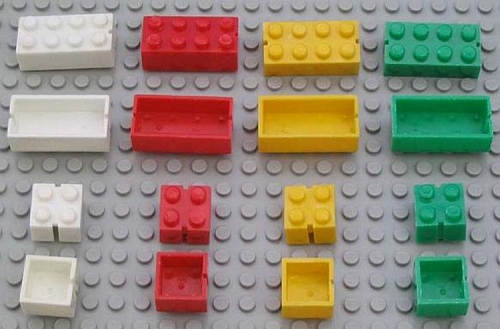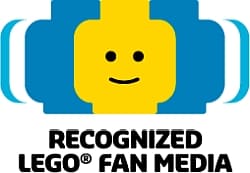(Written by Milos)
Children growing up in the last half of the last century had a choice of toys and other activities which had grown exponentially since the days of their grandparents. Mass production and the entrepreneurial spirit meant that novel products appeared on the market with monotonous regularity. Many of them were nine-day wonders, quickly consigned to the bottom of the toy chest and now only seen in obscure toy-museums. Among them, however, was a small and elite contingent of toys which went on to become icons of childhood. And few enjoyed that status to the extent that LEGO did.

The LEGO Automatic Binding Brick boxes of 1949-52 all had this same box top design. These were sold only in Denmark, and briefly in southern Sweden.
For millions of kids – boys especially but not exclusively – LEGO was the first toy they demanded themselves. What boy in the last fifty years hasn’t demanded LEGO, LEGO and more LEGO from the age of about five?
LEGO had everything: it was simple, durable and endlessly versatile. From a handful of simple blocks, a child could build anything: the only limit was his imagination. And as he exercised that imagination, the sky was the limit. Literally. Because those simple shapes did not impose any final result; there were no instructions and no “right way” to assemble the LEGO blocks.
Today, LEGO has changed. The basic simple blocks are still around, but every year it’s harder to find them except in the form of a kit with instructions for building specific shapes. And they come with an ever-increasing range of specialized pieces, character pieces and a growing palette of colors. These days a LEGO kit is likely to come with step-by-step instructions on how to assemble the pieces for a very specific outcome. LEGO still provides valuable practice in dexterity and requires the new skill of following instructions. But does it still exercise the imagination?
 Susan Linn thinks not. Linn is an instructor in psychiatry at Harvard Medical School and author of The Case for Make-Believe: Saving Play in a Commercialized World. In a 2009 interview, she warned that the trend towards structuring children’s play was stifling creativity. She sees the decline in imaginative play for children as a spiral driven by corporate profits. Children who play creatively, says Linn, are just not as dependent on the franchise-driven toys sold by big corporations.
Susan Linn thinks not. Linn is an instructor in psychiatry at Harvard Medical School and author of The Case for Make-Believe: Saving Play in a Commercialized World. In a 2009 interview, she warned that the trend towards structuring children’s play was stifling creativity. She sees the decline in imaginative play for children as a spiral driven by corporate profits. Children who play creatively, says Linn, are just not as dependent on the franchise-driven toys sold by big corporations.
Many would argue that LEGO fell into this trap when it first entered the franchise game with the introduction of its Star Wars line in 1999. At the time there was fierce opposition within the country, as Charles Fishman recounts. But in fact the change had come much earlier with the introduction of themed sets: the town, farm and space-oriented sets were still versatile, but it was a first step towards the narrowing of the universe the child imagined when he opened the box. Since then the range of kits designed to build just one, very specific model has expanded, all the way to the LEGO Boeing Dreamliner.

There’s no disputing that LEGO today brings more pleasure to more children than ever before. It is still one of the most iconic toys of all time. However it’s unlikely that today’s ten-year-olds will save their LEGO kits to pass on to their children, as many of their parents and even grandparents did. It’s hard to imagine a ten-year-old in 2035 spending much time with the LEGO Boeing.
The great genius of LEGO at its launch was the unlimited number of permutations which could be derived from a handful of geometric pieces in just two colors. It provided an endless horizon for the imagination of the child. As media and big corporations conspire, perhaps not intentionally, to limit and steer every choice made by a human being from a very early age, has LEGO also become an accomplice in narrowing the world of the child’s imagination? What do you think? 😕
Also, if you are interested in LEGO history you might want to check out:














I just purchased the XXL LEGO box (set 5512) for my son on a Black Friday online sale. Of all the LEGO sets I have purchased recently, this is the one that I am most happy about his using. There are no instruction, just bricks. When we dumped them out on the floor, he immediately started building and created a tower, a hammer, a duck, a dog, and more.
I definitely feel that the CREATOR and BRICKS & MORE sets are the best for creativity. A few minifigs are great, but I would steer my children away from the licensed sets and other sets that are little more than preset models. Those are fun for collectors, but not great for imagination.
I think there are two things at work here that are mistaken by the researcher.
First, the assumption kids of 5 or 6 will start with these big sets.
Second, the fact that kids and parents mostly keep sets as is.
Let me explain further, kids might get a set (not the Boeing), but you start smaller. This set is build and most likely end up in a pile of old LEGO from your parents or older sibling.
Now the real LEGO fun begins, kids know how to build cars, houses etc.
Only kids that are not encouraged to play and think for themselves will stick with instructions. I know mine quickly start making their own fantasy buildings with their new parts.
There was a time LEGO made he juniorized parts we all hate, but I think they are getting better at it.
Do not only look at the sets we as adults like, but check the sets for the smallest ones. This is were most of us start, after that we might finally get a Boeing, but I think by then we are old enough to build our own airport with the bricks we have.
We love nothing more than diving into a big pile of bricks and build build build(c:
My conclusion on what I have seen and experienced (sorry, this is very black and white) :
Parents that do not play with or help their kids with their play, create (mostly) narrow minded kids.
While parents that play with and stimulate, show their kids what can be done will likely get smarter and brighter kids.
This goes not only for LEGO, but in other fields as well, my kids know at least 10 different birds by name, know about trees, traffic signs etc.
This comes from talking and showing these things from a young age.
At my kids school they explained it in a nice way.
Most parents ride their bike with their kid behind their back, the kid only sees left or right, a narrow part of their world.
We as parents take our kids in front of us on the bike, now they see much more, plus we interact while biking.
Look at your right, a bird, look left, a windmill etc.
Apart fom showing them a bigger world they also get to see what we see, learn directly from us.
Now think of the parent driving (a bike or car or whatever) or sitting on the couch, NOT interacting with their kid.
Which one is more likelly to be a smart individual.
Great piece, it does make you think, but also understand, researchers often work towards their conclusion, not the other way round(c;
You can still buy buckets of bricks, and play with the sets. I buy sets for the pieces that I like, not necessarily to build.
I still think that LEGO helps children with imagination and creativity. Probably not as much as the earlier sets but you must remember that a LEGO set is not just supposed to just be kept together forever, it’s supposed to taken apart and made into something new from your imagination.
But with the new large pieces (i.e. the fronts to some of the airplanes and trains) it’s hard to use it in it something new. Lego just has to remember when they make new molds for LEGO pieces to try and make it so it can be used for different things besides what it was intended for.
I’m sorry, but i have to disagree with many things in this post. I do understand nostalgia for old things from our childhood, and it is true that there are many toys that are completely useless for fostering creativity, but to lump Lego in there? Nah.
You say that basic Lego sets are harder to find. I’m wondering if you have been to a Lego store or any other store that sells Lego? Basic brick buckets and creator sets are always available in great variety. Yes, now there are licenses sets too, but nobody is forcing you to buy them.
Also, I would make the case that it is in fact the original Lego sets that were greatly limiting imagination. All you got was square bricks! So what did kids build? Square things! Houses, towers, maybe castles. I do remember my frustration with early Lego as a kid and trying to bend it to my vision. I wanted to build cool spaceships! Not square things! And I wanted them in the right colors too! Not red and white! Kids are creative, but they also have practicality and taste!
Now there are many elements to choose from and to say they are only good for one thing is just wrong. Have you visited flickr or mocpages and see what today’s kids are doing with all the specialized Lego elements? Their creativity is just mind boggling! The unusual and organic MOCs they are building are simply stunning! And yes, they use regular Lego bricks as well as specialized elements in the most unusual and creative combinations.
I think Lego’s creativity greatly expanded and now the possibilities are pretty much limitless. Lego is good at keeping its roots and staying connected with today’s kids. I’m very happy with the development of the company. It offers options to both creative people and collectors. There is nothing wrong with either. And as Maxx said, if kids are not creative, especially with Lego, blame the parents!
Totally agree! I just read the unspeakable on Amazon.com. One parent was tired of 8095 General Grievous’ Starfighter always falling apart and frustrating the child, so he/she [GASP!] glued the thing together! THAT stifles creativity. It doesn’t kill it, mind you; I think action figures are decent for creativity, too, but it DID kill the whole beauty and versatility of LEGO.
Guys (and gals), this is controversial article and it was intended to provoke your opinions. Of course LEGO is still on of the best creative toys you can buy for your child, but at the same time, licensed sets that are available in the last decade, in my humble opinion, do narrowing child creativity.
By default, licensed lego sets are more expensive (usually ridiculous expensive) and because of specific shapes, cant be reused easily to build something new outside of it’s intended purpose. For example take The Tumbler from LEGO batman set, £695 for a lego set! Although this is “collectors set” it’s a bloddy toy! 🙂
2 weeks ago I bought my 6 years old son Ninjago Spinjitzu Dojo set, he alone assemble it in 2 hours. He loves it and plays with it every day for the last 2 weeks. He’s watching ninjago cartoon every day and immediately after the cartoon is finished he rushes to his room to play with his Spinjitzu Dojo set. Do you think he wants to dissemble it and make something new, not a chance!
They watch the LEGO ads, they watch LEGO cartoons, they play LEGO games and yes, LEGO company is narrowing their horizons all because of the company profits.
Many of you will disagree and some will read between the lines, but the bottom line, LEGO was much more creative when I was a kid. 🙂
Hi Milos,
I think you are talking yourself into a hole you can’t get out of, please re-read what you yourself said about your son:)
“He loves it and plays with it every day for the last 2 weeks.”
So you are saying, because he doesn’t take it apart, he is not really playing with it or using his imagination?
Then what IS he playing….
In the end it will come down and other things will be build with it, but like you said, he is just 6 (c:
LOL! Tough crowd! When I was a kid my brother and I loved building LEGO space-ships. We built them, kept them, sometimes modified them and played with them for weeks. Then, when we weren’t home our Mom used to take them apart! She felt that we were not creative anough by keeping the same MOCs for weeks. I have become more creative… at hiding things! 😈
I disagree with this article mostly. First of all, I buy two kinds of sets, new sets, and rarely, old sets for display. The old ones I keep, as I bought them for the sets, not the pieces. These are sets from the 80s. New sets I buy, do not last more than a couple of months before they are taken apart to build some other imaginative thing.
Also, licensed sets do not necessarily limit creativity. They can be kept and played with, but then they can have backgrounds and additions built. I think they just help fuel creative ideas.
I am sorry but this researcher has never been to MOC pages or a Lego convention. If anything the new sets allow kids to expand their creativity will all the new and specialized pieces and they cater to the adults who still play and build with legos. Other toys out there do support her claim. Many items in the toy isles can never be used for anything other than their main design. Lego is only limited by the person imagination.
The researcher should go and see this:
https://accounts.google.com/ServiceLogin?passive=1209600&osid=1&continue=https://plus.google.com/104222106201849054845/posts/EogyfKZK8tn&followup=https://plus.google.com/104222106201849054845/posts/EogyfKZK8tn
I think it prooves our point(c:
Maxx, that’s just awesome! I have that Creator set, so I’m gonna try this challenge myself! 😆
You will love this one, true in 1963, still true today:
https://www.flickr.com/photos/31418128@N04/6255504644/in/faves-maxx361/
Great ad! You should write a post about it! It is way too funny and so true! Although I would add that current LEGO “can” shoot! To confirm I just flicked the cannon on my DUPLO pirate ship. It shot this big round cannonball across the room! Yeah, LEGO is rad! 😆
Current LEGO Ninjago can also spin(c:
Maxx, yes, spin they can! Actually the spinners are really awesome and they can spin for an impressively long time! The Spinjitzu game is quite fun! 😉
I’ve enjoyed reading the article along with the various comments. My grandkids love the kits, but once they’ve been made, all their new LEGOs join their old LEGOs in various plastic drawers. I’ve added several LEGOs apps including LEGO Instructions which gives step by step directions to make new projects from their old LEGOs – lots of fun. And I was delighted when my grandson built a stable out of his wooden blocks and added LEGO characters to make his very own Nativity set. I have to agree with most that there is still plenty of creativity going on. Thanks again for a delightful visit.
As someone that’s been using LEGO for about 30 years I totally disagree with LEGO stifling creativity. As a kid, I always wanted specific Forest and Space sets. Mainly because I liked have little LEGO people to play with. After I put the sets together per instructions and played with them awhile, I took them apart and built something else. If anything, this forces you to expand your imagination. It takes a lot of creativity to find out what you make from a limited number of bricks in a particular set.
I very clearly remember this one “spaceship” I built and how blocky (only square pieces) and not really spaceship like it looked. But in my mind at the time, it was the coolest thing I ever built.
Surely, unless parents take an obsessive hand, most bespoke lego sets end up in the ‘general’ box. My kids’ did. I’ve worked with kids for yonks, in play projects. We ran a Fun Bus (play centre on wheels, converted double decker) for 28 years, had a general lego box throughout. Popular with all, boys always make guns first but then progress. It’s been …. the material for effects for a video space movie the kids were making …. and everything else. Outgrowing it? So there we were with a Sunday afternoon session requisitioned by teenagers (skaters) (most of whom we knew from earlier years). When do you grow suspicious? When it goes silent upstairs. So I creep up, and listen at the top door, still no sound, I poke my head in and …..
a whole load of teen hulking louts sat on the floor cross-legged, or on tables etc, all with Lego, maybe 8-9 of them. “Okay lads?” “Cool” etc All between 15 and 17. They wave me away. They come down for coffee and I venture “What’s with the Lego guys?” “Oh that. It’s great we can come here and no one moans or takes the piss” “Sometimes I just want to play and I can’t, but it’s OK here” “When I go in my kid brother’s bedroom and start to get it out, he moans ‘Muu-uum!!!’ the little creep” Says a lot that, about lego and about kids.
Nicely said! Love your British English too! 😀
I don’t have time to read all the comments right now, but just wanted to say that I completely disagree with this post. More colors and pieces just means more ways to be creative. Think of cheese slope mosaics…. a whole world of creativity that would have been impossible with having a cheese slope available in the palette of bricks. Furthermore, every kid I’ve ever known has taken apart their sets, dumped them all together into a bin of some sort, and then built new things out of all those bricks. The abundance of parts and colors doesn’t hamper imagination, but expands it. Or so I think. 😉
No arguing with the Queen of cheese-slope mosaics! 😉
Yeah! I’ve noticed that mostly on castle-era sets. Like the old Castle sets
had more creative pieces, but the Kindoms sets have bigger, specialized
pieces. You can’t do much with large, special pieces.
Ashton, you may want to check out the new Kingdoms Joust set. It is a very intricate building experience, similar to the Modular Houses. I think you woul denjoy it! 😉
I disagree with this based on my experience with my seven year old son. He loves all the kits. He does build them using the instructions, but he also takes them apart and builds completely new things with the pieces. He’s built entire villages. I also don’t see a decline in him using his “imagination” in play with legos or in other play activities. He plays all sorts of things with his friends using imagination. I think the kits give them a starting point, but that’s about all. Although I also disagree with the theory that video games lead to couch potatoes. My son loves video games, but he would rather be outside playing and riding his bike. I think it is all what parents allow.
Amy, yes, a lot depends on the natural inclination of the child, and also the parents. LEGO did put more effort into providing alternate models and building instructions into sets back in the 70s and 80s. Nowdays, besides in the Creator sets, only one set of instructions comes with each model. Some kids are naturally creative and will figure out on their own that they can build whatever they want. However other children are more rigid by nature, and can’t imagine building something outside the “official” model. Parents can encourage them, but not every child gets that kind of support. Though with LEGO the potential to be creative is always there. 😉
Yes, I think not only do Lego sets limit creativity, the very nature of square building blocks limits the design possibilities for tomorrow’s builders. Lego Earth Ship or Rammed Earth House, anyone?
This article is incredibly informative about Rice in India! From Basmati to Parboiled, India truly offers a rich variety. For trade-related inquiries, head to Tradekey to learn more.
Global B2B Platform is a leading online marketplace that connects businesses worldwide, facilitating trade and collaboration across industries. With a focus on providing reliable and efficient services, we offer a wide range of products and solutions to meet the diverse needs of our global clients.